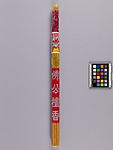cheuhng sou heung (Incense)
About this object
History of use
Hakka and Cantonese people in Hong Kong who practice Chinese popular religion burn paper offerings as a way of transmitting them to gods and ancestors, as do other Chinese sub-ethnic groups. The imagery of the offerings represents actual objects such as clothing, money, gold and silver ingots, and even special objects believed to be desired by individual ancestors such as cars, servants, and houses. People believe that ancestors receive them as actual objects to be used by them in the underworld. These are offered during funeral rituals and at ancestors’ graves and tombs when ancestors are worshipped during festivals dedicated to this purpose, Ching Ming in the spring and Chung Yeung in the autumn. In addition, incense and candles are burned as offerings for both gods and ancestors. Larger sticks of incense are burned for high-ranking gods. The incense is made of ground sandalwood, rolled by hand onto the sticks. People also make offerings of food, wine, and tea to both gods and ancestors. The food offerings are carefully prepared and arranged on serving dishes, and placed on special tables in front of the altars in temples, halls for worshipping ancestors, and shrines dedicated to particular gods. There is a hierarchy of gods and the highest are worshipped first, although not all may be worshipped in sequence. The highest are the Heavenly Gods and individual high-ranking gods with responsibility for particular territories or people in particular occupational or other categories. These gods may have temples devoted to them. Below them are gods responsible for protecting villages, wells, etc. and who have shrines where they are worshipped. Below them are gods who protect households. There are differences among the ritual practices of various south Chinese sub-ethnic groups. Hakka people worship with a whole chicken, pork, and sometimes a whole roast pig, and squid, as well as fruit. They also do not differentiate the paper offerings, and simply burn them all together. Cantonese people offer them separately, and use a whole chicken, cut up, when worshipping gods, together with a fish, a bowl of rice, and fruit. Hakka people burn incense and candles on the 1st and 15th of the lunar month, while Cantonese people should worship every morning and evening. Low-grade paper offerings are also used to placate ghosts in some situations. Some groups make special offerings to wandering ghosts in the 7th month, when they are released from the underworld. For Hakka people, regular worship is normally performed by women, whereas men are responsible to the Ching Ming and Chung Yeung worship of ancestors, although women assist.
Narrative
From a ritual goods shop in Tsuen Wan, Hong Kong. Relatively large sticks of incense like these would be burned as offerings to higher-ranking gods. Some people also offer three very large sticks of incense, or thick coils that would hang from a temple ceiling and burn for a long time. Mrs. Kwok Fung, Yin-ha, of Tsuen Wan, Hong Kong, gave invaluable help to Elizabeth Johnson in the selection and purchase of these offering materials and in explaining their meaning and how they were used.
Physical description
Plastic package of twelve long incense sticks. Bottoms of sticks are wrapped in pink metallic paper. Three pieces of paper are wrapped around the incense: a red strip of paper with silver characters; a circular, metallic golden symbol; a colourful tag with characters and the image of a monk-like man suspended within a circle.
Materials
